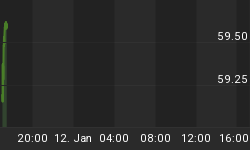U.S. wholesale prices (PPI) rose a full 1 percent in July as energy costs surged. This is the biggest one month increase in 9 months, and twice the increase that had been predicted; the so-called "core measure" that excludes food and energy rose 0.4%, the most since January. Note that the PPI shows month-to-month changes, not an annualized number. The report follows the recent consumer price index release whose "core" number was in-line with expectations; the "core" number, while excluding food and energy, did not exclude the steep discounts given in the automotive industry.
While some tell us that inflationary pressures are temporary and primarily due to bottlenecks in the energy sector, we have long argued that inflation in all commodity prices is not a temporary supply issue, but driven by the global imbalances. Global over-production to sell to the U.S. consumer is fostered through low interest rates and tax cuts in the U.S. and subsidized exchange rates in Asia. So far, the U.S. consumer has enjoyed low prices as U.S. manufacturers cannot pass on higher raw material prices due to a flood of competing cheap Asian imports. Goods and services that cannot be imported from Asia have had substantial inflation in recent years - we shall only mention the cost of health care and education.
While some production and refining shortages may be temporary, we believe the upward pressure on commodity pressure and downward pressure on the dollar will persist as long as global economic policies do not change. The enormous U.S. current account deficit and a non-existent U.S. savings rate (American households use their homes as ATM machines) are a reflection of imbalances in place.
Even as China has moved to a basket of currencies to provide a mechanism to de-couple from the dollar, we see neither China nor the rest of Asia giving up trying to sell to the U.S. consumer anytime soon. Similarly, in the U.S., the administration has made it clear that growth is its top priority; as a result, we believe that the administration will appoint a successor to Federal Reserve Board Chairman Greenspan who is pro-growth; we mention former Fed Governor and the administration's current Chief Economic Advisor Ben Bernanke as a likely candidate. Bernanke has become known for his quote that he would be willing to throw money out of helicopters to keep an economy from falling into deflation; he is also known as an advocate of managing the entire yield curve actively, not just short-term rates as is the traditional domain of central banks.
Aside from inflationary warning flags in the published indices, "froth" in various regional housing markets has been widely reported. The Fed has been increasing interest rates slowly, but steadily in an attempt to "normalize" interest rates again. However, the Fed faces a challenge: it must deflate the housing bubble, contain inflation and yet does not want to throw the U.S. economy into depression. But at the same time, the Fed has contributed to an enormously leveraged economy, where even small increases in interest rates have a magnified effect on U.S. households. We believe the Fed will stop raising interest rates at the latest when the U.S. economy dips into recession, but that may not be sufficient to contain inflationary pressures. Just as inflation cannot be turned off like a light switch, the unwinding of the global imbalances will be long and painful. At the same time, there will be forces that don't want this adjustment to take place: Asia is far more interested in political stability by providing jobs for millions of workers joining the workforce than to lose sales to the U.S. by letting their currencies appreciate. And U.S. politicians may not get re-elected if they promote savings rather than growth.
In the meantime, after the worse than expected wholesale inflation numbers were released, the dollar had a small rally and oil and gold prices fell. Amongst the headlines was a comment that all is well given that the Fed will now raise rates further and keep inflation under control. Let the oil price rise $5 and it is a temporary phenomenon; let it drop $1, and we have seen the end of the commodities bull market. Short-term, we leave it up to the speculator to determine prices. We believe the heightened volatility is likely to remain with us for some time. Gold is traditionally less volatile than oil, because it has fewer industrial uses and is less exposed to supply and demand shocks. But we see the long-term pressures on the dollar remain firmly in place, which should bode well for gold and non-US dollar hard currencies.















